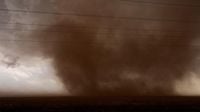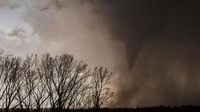On the evening of November 7, 2025, the quiet town of Rio Bonito do Iguacu in Brazil’s southern Parana state was transformed in a matter of minutes. What began as a routine Friday quickly spiraled into chaos as a tornado—one of the most powerful in recent memory—tore through the municipality, leaving death and destruction in its wake. By the time the winds finally subsided, the town, home to about 14,000 people, was left reeling from devastation that local officials and residents alike described as nothing short of a "war zone."
According to Parana’s civil defense and multiple news outlets, at least six people were killed and more than 600 injured in the disaster. As rescue teams scoured the ruins for survivors and the missing, the number of casualties remained fluid. Two people were still unaccounted for the following day, and authorities warned that the toll could rise as the search continued. Local fire chief Jonas Emmanuel Benghi Pinto cautioned, "The number of victims could increase overnight as the search operation continues."
The tornado, classified initially as an F2 supercell by meteorologist Reinaldo Kneib, packed winds between 180 and 250 kilometers per hour (113 to 155 miles per hour), according to Parana’s environmental technology and monitoring system. Meteo agency Metsul reported that these ferocious gusts were strong enough to flip cars as if they were toys, rip roofs clean off buildings, and even topple entire brickwork houses. "There were reports of overturned vehicles, fallen trees and even entire brickwork houses being destroyed," Kneib explained when discussing the scope of the destruction.
In Rio Bonito do Iguacu, the tornado’s impact was catastrophic. Civil defense officials estimated that 80 to 90 percent of the town suffered some form of damage. Mayor Sezar Augusto painted a grim picture: "It’s rained very heavily and about 80 percent of the city is in ruins. The force of the storm knocked down power lines, ripped roofs off buildings, destroyed structures, and caught many people returning home. There are many vehicles under the rubble. There are at least three deaths, including two elderly people. There are also many injured, and the hospitals are overcrowded." Social media was soon flooded with images and videos showing homes reduced to piles of debris, electricity pylons lying across streets, and a lorry on its side—testament to the tornado’s raw power.
The destruction extended beyond Rio Bonito do Iguacu. Damage was also reported in the Parana state municipalities of Candoi, Larenjeiras do Sul, and Guarapuava. In Londrina, at the state’s northern edge, terrified travelers at the airport were filmed running for cover as winds reached 60 miles per hour. Across the region, about 60,000 homes lost power in the storm’s aftermath, compounding the misery for thousands of families.
Inside Rio Bonito do Iguacu, the human toll was staggering. Hospitals were quickly overwhelmed by the influx of wounded—many with head injuries and other trauma. Outside the main hospital, “at least three teams of doctors and nurses [were] scouring the city to see if there are people trapped under the rubble,” the mayor reported. To cope with the sheer number of casualties, authorities set up a field hospital in town and established a shelter in a nearby community for those left homeless. The local rescue agency detailed, "Initial reports also indicate that there are 30 people with serious or moderate injuries, and around 100 with minor injuries." But as the hours passed, those numbers only grew.
The scene was described by Fernando Schunig, head of the Parana Civil Defense agency, as nothing less than a battlefield. "It is a war scene," he told the news outlet G1, adding, "When these events hit an urban area, the damage is major. It is very lethal." The tornado’s path cut through the heart of Rio Bonito do Iguacu, striking residential neighborhoods, schools, and businesses. Roselei Dalcandon, standing by what used to be her shop, summed up the despair felt by many: "It destroyed everything. It destroyed the town, houses, schools. What will become of us?"
Governor Ratinho Junior of Parana moved quickly to reassure the public, posting on X (formerly Twitter), "Civil Defense and our security forces are on alert, mobilized, and monitoring the towns and cities affected by the severe storms. Our solidarity to the entire population of the affected regions. We remain in constant vigilance." He also expressed his own shock at the scale of the disaster, saying, "We already knew that we would face a difficult moment. But we never imagined that we would be hit by a tornado that could cause all this devastation." The governor was expected to visit Rio Bonito do Iguacu in person the following morning to assess the damage and meet with survivors.
Weather authorities had issued storm alerts for Parana and its neighboring southern states, Santa Catarina and Rio Grande do Sul, as conditions deteriorated in the days leading up to the tornado. Heavy rain and hail had already battered the region, but few anticipated the ferocity of the twister that would follow. The storm struck shortly after 5:30 pm local time, lasting only minutes, but the damage it left behind would take months—if not years—to repair. The state meteorological service confirmed that winds topped 150 miles per hour, a force rarely seen even in this storm-prone part of Brazil.
As rescue teams continued their search for survivors, stories of heroism and heartbreak emerged from the rubble. Volunteers joined firefighters, police, and healthcare professionals in the desperate effort to pull people from collapsed buildings and provide emergency care. A supermarket reportedly collapsed during the storm, with people trapped inside awaiting rescue. The mayor, overwhelmed by the scale of the crisis, said, "There are many injured people with head wounds." The sense of community was palpable as neighbors helped each other find shelter and comfort in the darkest of hours.
For now, the people of Rio Bonito do Iguacu and the wider Parana region face a long road to recovery. With most of the town’s infrastructure either damaged or destroyed, and with thousands displaced, the challenge ahead is daunting. But as the dust settles, the resilience and solidarity of the community are already on display—determined to rebuild, even in the face of unimaginable loss.





